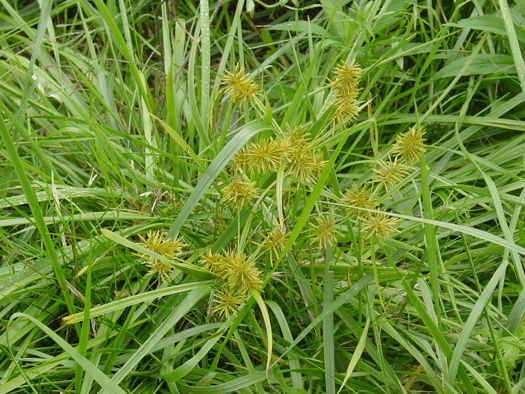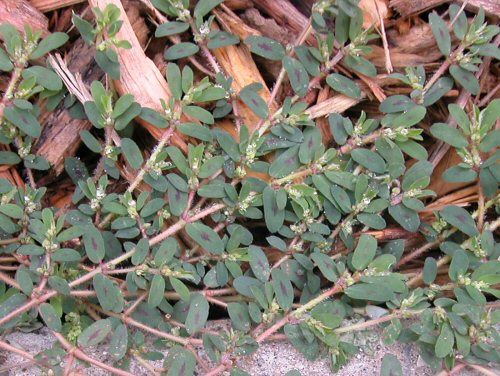I suspect that each gardener has a particular weed that is most bothersome, and in this garden the most prolific is nutgrass (nut sedge, below). There are three sections of lawn in the garden, all relatively small in comparison to the area devoted to planting beds and ponds. The section farthest from the house is the lowest in elevation, and following construction years ago of a storm water retention pond just beyond the rear border of the garden, the soil ranges from saturated in winter and spring to damp through the rest of the year. This is so perfect an environment for nutgrass that by mid summer this section of lawn seems nothing but, and so rather than battle a hopeless fight, I’ve given up. Thus, nutgrass is the least of my worries, even when it encroaches into the planting beds where clumps are easily pulled compared to other weeds.
Most bothersome in this garden is prostrate spurge (below), which in hours goes from nothing to a carpet covering any open, sunny space. The plant itself is not overly objectionable. It’s flat, so it takes little space, and its color does not stand out so that if the gardener is not looking out for it, spurge could easily blend in with mulch or whatever else covers the ground. Since spurge grows prostrate, it does not overwhelm neighboring plants, though it often becomes intertwined with other low growers to become nearly impossible to extricate.
Stiltgrass (below) is becoming more of a problem in the garden, and fortunately, it is easily pulled. I hope to get most of it before it goes to seed, and of course this is the problem with spurge. Weeds are weeds for a reason, and usually the reason is that they are tolerant of a wide range of conditions, or that they seed prolifically. If stiltgrass or spurge are not kept up with, there’s trouble ahead.
For better or worse, I am a fast weeder, and thus not often careful to remove weeds roots and all. In pulling quickly I often snap the top off a clover or spurge, with roots left behind, which I know will quickly regrow. But, as I analyze speed versus quality, the end result of clearing an area of weeds quickly substantiates the few that quickly regrow. Many gardeners will argue that this is a waste of time, and I won’t argue that some weeds must be pulled more than once, but this takes care of the largest area in the shortest time.
Nut grass is my favorite invader because it is so easy to pull. Every day when I get home from work I pull weeds before I go in the house. Your description of the spurge is most apt – it does literally spread in a couple of hours, and escapes notice for far too long. Many folks have gardening listed as a hobby. Mine is weeding.
Have you thought about planting elephant ears next year in your damp area? would make a great splash in the garden!
I’ve recently divided and transplanted carex, ferns, and a few hostas into this damp area, and I’ll be planted a few other carex cultivars this weekend prior to what I hope will be a substantial rain. I’ve planted elephant ears in this area, and in shallow areas of the ponds in past years, but I’m not so good at getting around to digging them out to store for the winter. After one mild winter several came back in the spring, but most years they’re killed in the freeze.
Virginia Buttonweed is my nomination for most bothersome and hard to eradicate weed, along with the aforementioned invasive Japanese Stiltgrass
Unfortunately, I see stiltgrass everywhere. It is along our highways, in forests, and in our gardens. While it’s an annual, it drops enough seed to spread itself liberally.
Thank you! I now have names for the nut weed and spurge. Already identified the stilt grass. Love your column!
Stiltgrass has yet to make it here, but I have seen it in the state forest just 20 miles away so I’m sure it’s just a matter of time. It’s amazing what a pest an annual weed can be.
Nutgrass wins though. I absolutely hate it since there’s always a bit left that returns. It’s not bad to pull, and doesn’t overwhelm anything, but it just won’t take a hint and leave.
I’m not too crazy about violets either.
Thanks for the identification of some of my weeds. The only good thing I can say about prostrate spurge, which comes up in my paver walkway, is that when I pull it the improvement is dramatic and immediate. The stilt grass appeared a few years ago and seems impossible to eliminate. I always learn something from your blog, though I rarely comment. Thanks!
Fortunately, roots of stiltgrass are easily pulled by grabbing a handful of foliage. Most important is to remove the grass prior to it going to seed.
For me the worst weed is Mulberry Weed which showed up in my garden several years ago and has spread rapidly even though I tried to remove all of it. It starts going to seed when only inches high and gets 2 feet tall. I also have trouble with smart weed and several different weeds that have burrs that the dogs spread. Stilt grass is also a big problem for me as well as mile-a-minute vine, bind weed, and several weeds in the lettuce family. These weeds keep me busy all growing season. I try to get the stilt grass as well as the other weeds pulled before they go to seed, but they come back every year anyhow. I would rather be in the garden than any other place and pulling weeds is part of being in a garden.